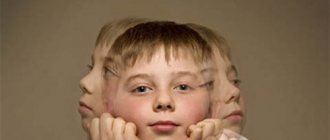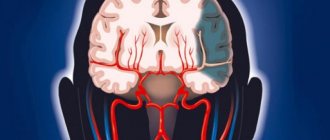Residual cerebral encephalopathy (RE) is a pathological condition caused by organic changes in cerebral structures against the background of ischemia, infections, injuries and other lesions. The severity ranges from minor impairments to severe neurological deficits that cause disability. The most common symptoms are headaches, paresis, autonomic dysfunction, and loss of consciousness. Intellectual and emotional disorders are possible.
To schedule a consultation, contact our operator by phone 8(969)060-93-93.
Causes
The etiology of EC in children and adults varies, but the underlying cause is always damage to brain tissue. In patients of younger age groups, the disease is most often associated with insufficient blood supply to the brain during gestation, during childbirth and in the first days after birth. The congenital form is provoked by factors such as intrauterine hypoxia, complications during childbirth, birth injuries, and the use of obstetric aids. Heredity, the presence of bad habits in the mother and the age of the pregnant woman play a certain role.
The list of factors that provoke RE in adult patients includes the following conditions:
- chemical dependencies: alcoholism, drug addiction;
- poisoning: salts of heavy metals, insecticides, other toxic substances, often as part of industrial hazards;
- radiation exposure;
- traumatic brain injuries;
- ischemic and hemorrhagic strokes, vascular thrombosis, hypertensive crises;
- cerebral atherosclerosis;
- infectious and inflammatory diseases of the membranes and tissues of the brain: meningitis, arachnoiditis, encephalitis;
- abnormalities in the development of brain structures and cerebral vessels;
- conditions after neurosurgical operations.
Determining the cause of the pathology is associated with some difficulties, since symptoms often appear many years after the adverse effect. In old age, the consequences of injury or infection may be superimposed by hypertension and atherosclerosis.
Other forms of dementia
When brain neurons are damaged as a result of impaired blood circulation, they speak of vascular dementia. It develops as a consequence of stroke or ischemia.
For dementia that develops as a result of a stroke, neurological symptoms are more typical: paralysis, paresis, speech problems. Ischemic dementia is accompanied to a greater extent by symptoms of dementia.
The main signs of vascular dementia include mental instability, absent-mindedness, irritability, sleep disorders, and low mood. Memory suffers, but with leading questions the patient remembers what was asked of him. Speech disorders are associated with pathological changes in the functioning of the speech-motor system, gait changes, and movements slow down.
Another common form of acquired dementia is alcoholic dementia. It occurs as a result of constant, uncontrolled consumption of alcohol for 15 years and affects the age of 40 years and above. With this form of the disease, thinking and memory disorders and inadequate emotional reactions come to the fore.
Personal degradation is manifested by maladjustment in society, loss of moral values, and lack of care for one’s appearance. Delusional statements are typical, often of a jealous nature. Tremors appear in the limbs and myopathies develop. The disease is also called alcoholic pseudoparalysis, as it can repeat the symptoms of progressive paralysis. In this case, differential diagnosis in the form of serological reactions is needed.
Huntington's chorea (Huntington's) is another form of senile dementia. It combines mental and neurological disorders, as well as choreo-like movement disorders.
The disease begins at the age of 45–50 years, its duration is 10–15 years. Motor dysfunction precedes the development of the disease. This could be a gait disorder, a change in handwriting - it becomes incomprehensible, frankly bad, ugly. Clumsy and inappropriate, involuntary movements are especially characteristic. At this stage, a decrease in mental abilities is noted.
Huntington's chorea is accompanied by psychopathic reactions of the following types:
- excitability – anger, irritability, short temper;
- hysteria - demonstrative behavior, tearfulness;
- isolation.
Due to the fact that pathological processes in chorea occur slowly, dementia may not be too obvious. In particular, some patients are able to perform primitive work, but when they find themselves in an unfamiliar situation, they get lost. Thinking has a spasmodic character.
Speech disorders are caused by choreatic contractions of the speech muscles. Subsequently, speech becomes scarce and the desire to talk is lost. Delusions often appear - jealousy, persecution, grandeur, poisoning. Hallucinations occur less frequently.
Neurological symptoms include hyperkinesis in the form of involuntary twitches of small amplitude. Such patients end their lives in a state of complete insanity; hyperkinesis ceases by this period.
Symptoms
Manifestations are characterized by significant variability, their nature and severity depend on the prevalence and severity of damage to nerve cells, the compensatory capabilities of the brain and the age of the patient. In infants, signs of encephalopathy of residual origin are increased or decreased muscle tone, unmotivated crying, lack of response to stimuli, or, conversely, frequent episodes of restlessness.
As the child grows, mental retardation, delayed speech development and motor skills are added to the listed symptoms. The presence of such manifestations with sufficient probability indicates the prospect of persistence of residual phenomena throughout life. It should be taken into account that the clinical picture does not always correlate with the severity of brain dysfunction; some signs disappear over time or are eliminated with the help of therapeutic measures.
Subsequently, residual phenomena such as emotional disorders and delayed psychomotor development come to the fore. Children sleep poorly and are characterized by increased tearfulness and irritability. Long-term consequences of perinatal residual organic encephalopathy may include insufficient control over one’s behavior, attacks of aggression, fainting, nausea, vomiting, headache, autonomic dysfunction, poor memory, and decreased learning ability.
Manifestations of the disease can be combined into several neurological syndromes:
- Intellectual-mnestic. Occurs with cognitive impairment, attention and memory disorders.
- Astheno-neurotic. Weakness, increased fatigue, emotional instability, depressive and hypochondriacal tendencies are noted.
- Vestibular-coordinating. Accompanied by dizziness and poor coordination of movements.
- Cephalgic. There are severe headaches.
In adolescent and adult patients, residual encephalopathy may manifest itself as follows:
- frequent migraines that are difficult to relieve with traditional methods;
- emotional lability: apathy, hypochondria, sudden mood swings, causeless crying, increased anxiety, attacks of aggression;
- intracranial hypertension, manifested by headaches, nausea and vomiting;
- autonomic dysfunction: instability of blood pressure, increased or decreased heart rate, sweating;
- insomnia: difficulty falling asleep, frequent awakenings, daytime sleepiness;
- in severe cases - convulsions.
Clinical manifestations of encephalopathy on a residual organic background range from minor to pronounced. In most cases, especially with congenital anomalies, traumatic or inflammatory genesis of the pathology, signs of increased intracranial pressure come to the fore.
A common symptom is persistent cephalgia, peaking in the morning. Characteristic symptoms include nausea and vomiting at the height of a painful attack, weakness, fatigue, blurred vision or spots before the eyes, and difficulty performing intellectual work. Half of the patients have vestibular disorders. Sometimes a decrease in the accuracy of small movements is detected.
What to pay attention to
Dementia is a disease that has a gradual onset. Its manifestations depend on the degree of development and localization of the process.
It all starts with minor changes. A person may begin to forget some things and get lost in familiar places. This is attributed to overwork, fatigue or age.
As the disease progresses, he forgets the names of loved ones, events that recently happened to him, is poorly oriented at home, and may ask the same question many times. There is a decrease in self-criticism and intellectual abilities. The patient loses basic skills: he cannot open the door or turn on the kettle. Such people need supervision.
At the final stage of the disease, complete degradation of the personality occurs. Patients lose the ability to perform usual actions: wash, dress, eat. Changes occur in the emotional-volitional sphere, a person ceases to adhere to the basic framework of decency.
Often such people leave home, and finding their way back becomes problematic for them. This is especially true for older people.
For example, an elderly woman left home and was absent for several days. All this time, her family did not give up hope of finding her, using all possible resources to do this. Unfortunately, they found her dead: the old woman fell off a cliff.
There are two forms of the disease: total and lacunar. In lacunar dementia, short-term memory is mainly affected. People forget events that recently happened to them, what they just wanted to do, what they were thinking about. In other areas, changes are insignificant; criticality towards oneself and others remains.
Total dementia gradually leads to complete impotence and personality disintegration. At the same time, all spheres of human life suffer: memory disappears, the ability to assimilate new information and apply existing knowledge is lost, interest in everything that happens disappears, moral principles are devalued. A man, as they say, loses his face. You can often hear statements from relatives of a patient: he (she) has changed so much, before he was a completely different person.
Diagnostics
The diagnosis is made by a neurologist. It is often associated with significant difficulties due to the significant period between the causative disease and the time of manifestation of residual encephalopathy. A thorough collection of anamnesis and complaints, a comprehensive laboratory and instrumental examination are necessary. The list of hardware techniques includes EEG, MRI and CT of the brain. According to indications, a spinal puncture is performed, and genetic tests are performed to exclude hereditary provoking pathologies.
Cost of services
| CONSULTATIONS OF SPECIALISTS | |
| Initial consultation with a psychiatrist (60 min.) | 6,000 rub. |
| Repeated consultation | 5,000 rub. |
| Consultation with a psychiatrist-narcologist (60 min.) | 5,000 rub. |
| Consultation with a psychologist | 3,500 rub. |
| Consultation with Gromova E.V. (50 minutes) | 12,000 rub. |
| PSYCHOTHERAPY | |
| Psychotherapy (session) | 7,000 rub. |
| Psychotherapy (5 sessions) | 30,000 rub. |
| Psychotherapy (10 sessions) | 60,000 rub. |
| Group psychotherapy (3-7 people) | 3,500 rub. |
| Psychotherapy session with E.V. Gromova (50 minutes) | 12,000 rub. |
This list does not contain all prices for services provided by our clinic. The full price list can be found on the “Prices” , or by calling: 8(969)060-93-93. Initial consultation is FREE!
Treatment
Therapeutic measures must be comprehensive. Drug therapy is complemented by lifestyle correction. It is necessary to normalize the daily routine, alternating work and rest, sufficient time in the fresh air, and moderate physical activity. Physiotherapy and sanatorium-resort treatment are recommended, and sometimes psychotherapy is indicated. Medicines are prescribed taking into account the existing symptoms:
- cephalalgia: analgesics and NSAIDs;
- migraine: medications from the triptan group;
- dizziness: betaserc;
- insomnia, psychoemotional disorders: adaptogens, sleeping pills, antidepressants;
- intracranial hypertension: diuretics.
How to treat RE is determined individually. Patients are prescribed nootropics and nerometabolites. Children, along with symptomatic therapy, are given classes with a psychologist and a defectologist. The most important role is played by the participation of parents who support the baby and regularly work with him.
The forecast for the future is quite favorable. In most cases, with adequate complex therapy, it is possible to achieve the disappearance or significant reduction of symptoms. Patients lead normal lives: they study various professions, work, and build families. In severe cases, residual effects may persist, mainly headaches and autonomic disorders.
To make an appointment, just call tel. 8(969)060-93-93.
The most common form of dementia
Among the causes leading to the development of dementia, Alzheimer's disease ranks first. The first mention of it dates back to 1906, and its discoverer is considered to be the German psychiatrist Alois Alzheimer.
The disease begins to manifest itself at the age of 55–70 years. This is one of the forms of senile insanity and refers to the atrophic type of dementia, when the destruction of brain neurons occurs. There may be several reasons contributing to this disease: internal diseases, obesity, low intellectual and physical activity, diabetes. A special place is given to the hereditary factor.
The disease begins to manifest itself with a violation of short-term memory. First, the patient forgets events that happened to him recently, and then those that happened a long time ago. A person does not recognize his children, mistaking them for deceased loved ones. He has difficulty remembering what he did a few hours ago, but talks in detail about what happened to him as a child. At this stage of the disease, the patient develops egocentrism and delusional ideas. Speech, perception, and motor disorders are observed.
The next stage is characterized by emotional disruptions. The person becomes irritable, grumpy, and shows dissatisfaction for any reason. He claims that his relatives want to get rid of him in order to take possession of his property, and his neighbors and friends want to slander him in order to spoil his reputation.
Intelligence decreases sharply: analytical functions suffer, reasoning becomes poor. Interests are narrowed, the opportunity to perform professional skills is lost.
Such people need care and supervision. Behavior disorder is manifested by vagrancy, uncontrollability in eating and sexual intercourse. Aimless actions appear, speech contains constant repetition of one word or phrase, and replacement of words with new ones. But, despite extensive degenerative changes, self-criticism remains.
At the final stage, the patient loses cognitive functions, the ability to care for himself, does not understand what they want from him, self-control and criticality are lost. Motor restrictions, paralysis, pathological reflexes, and convulsive seizures occur. The patient assumes the fetal position, refuses to eat, and cachexia progresses.
The disease lasts on average 10 years. But the earlier it manifests itself, the faster and more severe it progresses.
Unfortunately, at the moment there is no treatment that could stop the progression of the disease and return the patient to his former life. But early signs in menopausal women can be stopped with hormonal therapy.
Scientists have found that Alzheimer's in the early stages can be recognized by the nature of laughter. The fact is that in this case a person gradually loses control and does not understand what to laugh at and where it is inappropriate. He increasingly turns to black humor, laughs at absolutely unfunny, offensive, and sometimes tragic events, and at the failures of other people. Thus, one patient laughed at his wife when she was scalded by boiling water.
It is believed that a change in the sense of humor is an important criterion in establishing a diagnosis, since its diagnosis is, in principle, difficult.
Alzheimer's disease is a very common disorder. For example, Peter Falk, better known as Lieutenant Colombo, was also smitten by him. After he found out about this, he immediately stopped all his filming. Lately, the actor has completely forgotten about the existence of Columbo and wonders why people on the street call him by that name.










